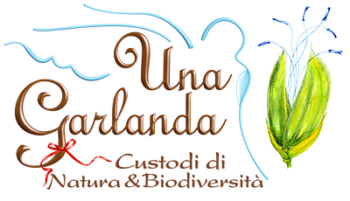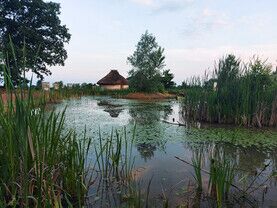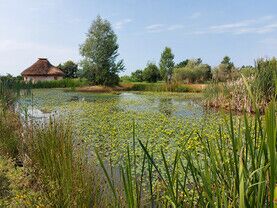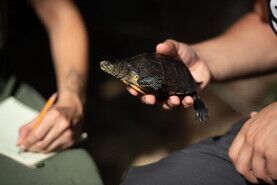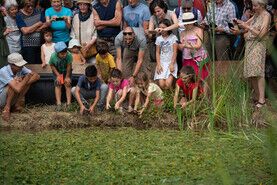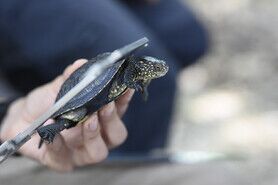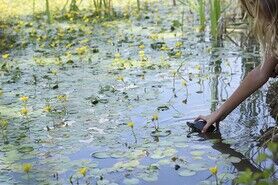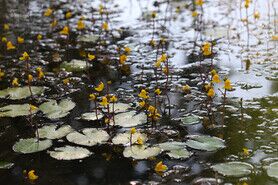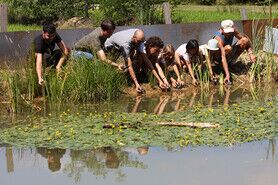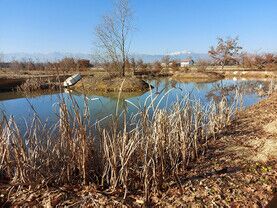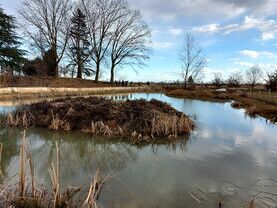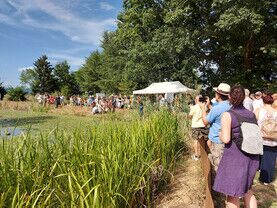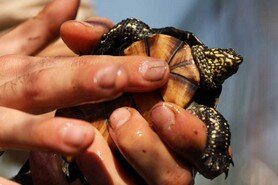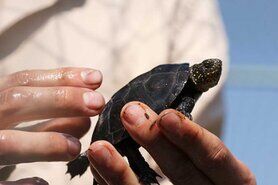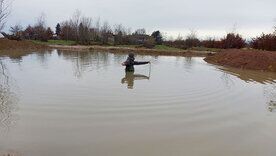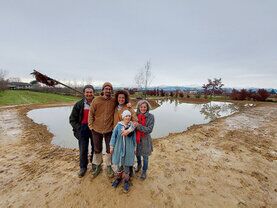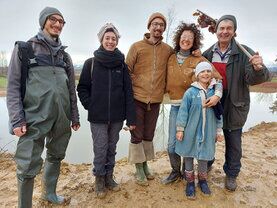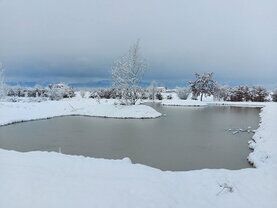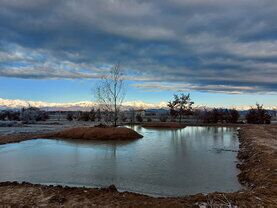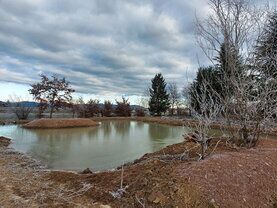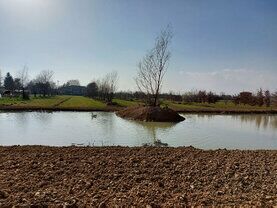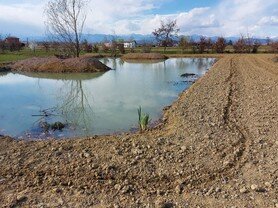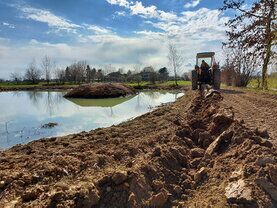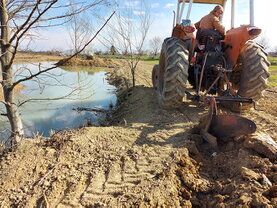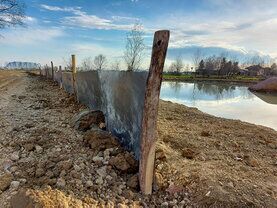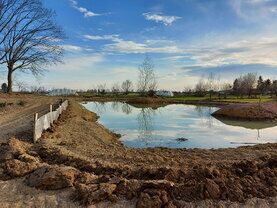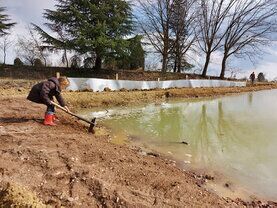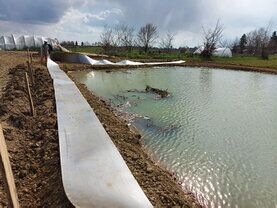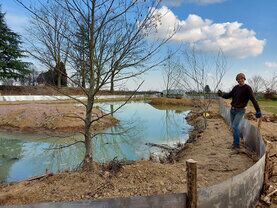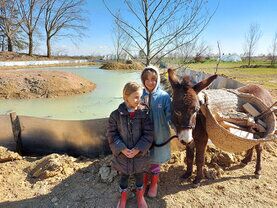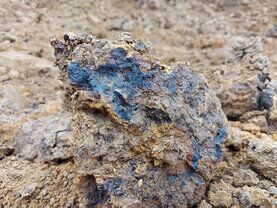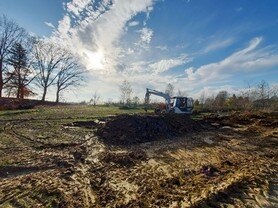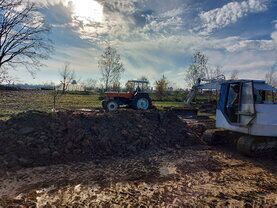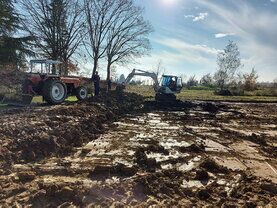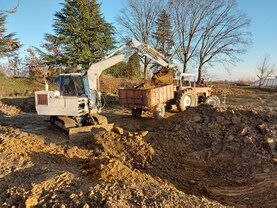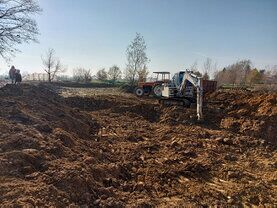Oasi Emys
l più recente tra i progetti di Una Garlanda, Oasi Emys
è un idea di "casa" per tutte le forme di vita emarginate ed in pericolo di sopravvivenza.
In collaborazione con l'Associazione Centro Emys Piemonte,
questo spazio palustre naturale nel cuore dell'azienda agricola,
diventerà piano piano una cellula di biodiversità protetta!
Per la testuggine palustre Emys Orbicularis e per tutti i vegetali, anfibi ed insetti
che compongono il suo naturale ambiente di vita.
Oasi Emys sarà anche punto di osservazione e sviluppo come zona umida
ad elevato valore di fitodepurazione delle acque destinate alla coltivazione del nostro riso.
articolo che parla del centro Emys:
Ti invitiamo a conoscere le giovani testuggini,
introdotte 26 Giugno 2022 e le continue evoluzioni di Oasi Emys dal vivo!
Perchè è veramente uno spettacolo straordinario!
Questa piccola area umida è un’idea di “casa” per tutte
le forme di vita emarginate ed in pericolo di sopravvivenza.
Dopo il Centro Emys Piemonte, questo sito è il secondo
esempio concreto in Piemonte, di ripristino ambientale idoneo
ad evitare l’estinzione della testuggine palustre Emys orbicularis.
La testuggine palustre Europea Emys orbicularis fa parte
della numerosa famiglia di testuggini semiacquatiche degli Emydidae,
le cui origini risalgono tra gli 80 e 90 milioni di anni fa.
Dopo millenni di pacifica evoluzione, in pochi anni, gli habitat idonei
di vita e riproduzione della testuggine Emys si sono notevolmente
ridotti e frammentati, generando un veloce declino di questa specie
ed un impoverimento genetico dei pochi esemplari presenti
tanto da portare all’estinzione di intere popolazioni,
anche nella Baraggia Rovasendese.
Le giovani testuggini rilasciate in questo sito nel 2022, stanno formando
una popolazione riproduttiva stabile. Il virtuoso e ramificato incontro
tra la biodiversità di luoghi protetti e le attività agricole policolturali,
potranno dare in futuro servizi eco-sistemici sempre più ricchi e attenti
alla qualità della vita e del cibo che ci nutre.
Attenti! da quando il mondo si è globalizzato una specie alloctona ( non di questi territori ) di testuggine
tra le più invasive, chiamata Trachemys scripta ha preso il posto della autoctona Emys orbicularis.
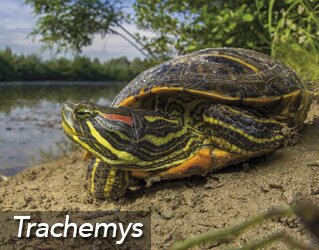
Purtroppo per la sua voracità e il suo proliferare, causato principalmente
dal continuo e illegale rilascio di esemplari adulti ben alimentati in cattività
poi abbandonati in natura, sta limitando la sopravvivenza
della nostra specie selvatica occupandone gli spazi e potenzialmente,
aumentando la diffusione di patologie.
E’ quindi molto importante non acquistare, far riprodurre e rilasciare
la testuggine americanaTrachemys in Natura, essendo previsto l’obbligo
di eradicazione a livello Europeo e vietato l’abbandono in tutta Italia.
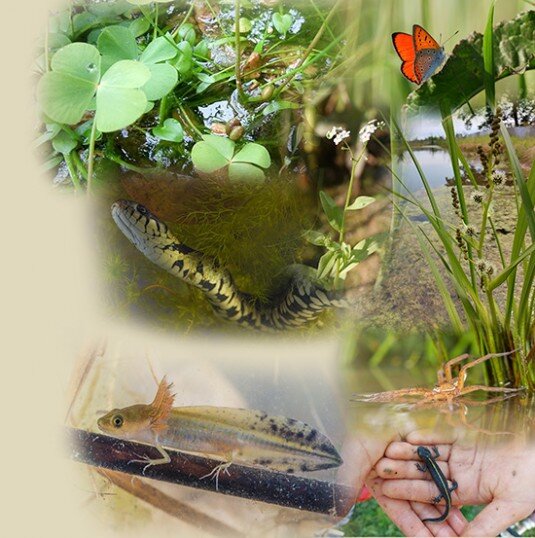
Un’oasi “Biodiversa”!
Insieme a Emys orbicularis in questa oasi
potrete inoltre ammirare piante autoctone come:
1) Limnantemio ( Nymphoides peltata)
2) Lenticchia d’acqua ( Lemna minor)
3) Nannufaro (Nuphar lutea)
4) Ninfea comune(Nymphaea alba)
5) Morso di rana (Hydrocharis morsus-ranae)
6) Erba vescica comune (Utricularia vulgaris)
7) Tifa (Typha latifolia)
8) Castagna d’acqua (Trapa natans)
9) (Potamogeton natans)
10) Quadrifoglio acquatico (Marsilea quadrifolia)
Aracnidi:
11) Ragno pescatore (Dolomedes plantares) (VU)
Anfibi:
12) Tritone crestato italiano (Triturus carnifex)
13) Rana verde (Plelophylax sp)
14) Raganella italiana (Hyla arborea)
Rettili:
15) Natrice dal collare (Natrix natrix)
16) Biacco (Hierophis viridiflavus)
17) Lucertola campestre (Podarcis siculus)
Ciao Sono Emys!!
Vivo sulla crosta terrestre da tanti tanti anni,
Il più antico fossile ritrovato in Kazakistan che mi assomiglia,
risale a 12 milioni di anni fa.
Sono criptica e pacifica e per adattarmi all’ambiente che mi circondava
il tempo e la selezione naturale hanno trasformato il mio corpo
riuscendo così ad evolvere e sopravvivere fino ad oggi a differenza
dei miei lontani parenti dinosauri.
Cosa rende me e le mie sorelle testuggini esseri
unici in tutto il regno animale!?
Seguimi e lo scoprirai..
Le mie Dotazioni evolutive
Il guscio che mi racchiude è l’unico modo che ho per difendermi
dai predatori; si è generato dalla fusione delle vertebre e le costole
che si sono modificate appiattendosi e fondendosi tra loro,
diventando la mia formidabile “corazza” che è composto
da una parte superiore( carapace) ed una inferiore ( piastrone)
quest’ultimo piatto nelle femmine e leggermente concavo nei maschi.
I miei lontani antenati più simili a lucertoloni, circa 300/260 milioni
di anni fa, hanno iniziato le modifiche strutturali della gabbia toracica
che è diventava sempre più compatta. In questo modo la forza muscolare
delle loro zampe aumentava permettendogli di scavare profonde tane nella terra.
E’ così che sono riusciti a sopravvivere ai tanti cambiamenti
nella millenaria evoluzione della mia specie e farmi arrivare oggi
nel ventunesimo secolo!!!
Sono l’unico animale che racchiude nella gabbia toracica/ guscio
anche il cinto pelvico ( ossa e articolazioni del bacino)
e il cinto scapolare ( ossa e articolazione della spalla).
Per difendermi mi chiudo dentro al guscio e...aspetto!
Sono primitiva e saggia
Per respirare i miei polmoni si sono adattati a espandersi
nella zona clavicolare ( sotto al collo) e inguinale ( prima della coda),
invece che nella zona toracica, e vengono attivati
anche dal movimento delle mie zampe.
La testa appare grande ma la mia scatola cranica a capacità primitive
e manca del foro parietale e delle fosse temporali.
Sono testarda e determinata, quando trovo un ostacolo
cerco in tutti i modi di superarlo e affronto la mia vita basandomi
su istinti primordiali.
Nelle condizioni ottimali posso vivere tanti tanti anni.
Il sole mi scalda e in acqua sto bene!
A terra sono abbastanza agile e i maschi della mia specie
abilissimi arrampicatori.
In acqua tutti i miei sensi sono accentuati:
nuoto veloce, rimanendo per lunghi periodi in apnea,
riesco a far entrare l’acqua dalla bocca
e farla uscire dal naso per conoscere i sapori e gli odori che mi circondano.
Non ho orecchie esterne, ma come molti rettili possiedo
una membrana che fa da timpano, permettendomi di raccogliere
le onde sonore che in acqua sono amplificate; mi è facile quindi
distinguere le prede ed individuare i pericoli.
Sono onnivora mangio principalmente artropodi ( insetti, ragni e crostacei)
e vegetazione che popolano i miei habitat, ma non disdegno
anche piccoli avannotti e anfibi (sia girini che adulti)
quando riesco a prenderli.
La mia vita a 4 stagioni
Vivo in piccole comunità e quando divento fertile
(dopo 10 anni per le femmine e 7 per i maschi)
cerco un compagno/compagna.
Quando arriva il momento, in primavera depongo
mediamente da 4 a 6 uova in un buco, che scavo dove la terra
è più sabbiosa, stando poi molto attenta a richiuderlo
e mimetizzare il “nido” per evitare che venga predato.
Lascio alla terra il compito di “covare” le mie uova.
Le differenti temperature di ogni estate potranno
far nascere: più femmine se la temperature andrà dai 29°C fino ai 30°C,
più maschi se sarà inferiori ai 28°C.
Ho un solo buchino sotto alla coda che uso
per fare la cacca, la pipì e per riprodurmi;
a lato ed internamente a questo buco
chiamato “cloaca”, ho due piccoli sacchetti
chiamati “sacche cloacali” altamente
vascolarizzate.
Trascorro tutto il periodo Invernale in letargo sott’acqua
ottimizzando le riserve accumulate. Quando serve aspiro dalla cloaca
dell’acqua e riempio le sacche cloacali che assorbono tramite
le pareti l’ossigeno contenuto nell’acqua, permettendomi così
di “respirare” in attesa di destarmi.
A Primavera riprendo piano piano le mie attività quotidiane: esplorare, cacciare,
mangiare, accoppiarmi e scaldarmi beatamente al sole su un tronco.
Se guardi bene mi portai trovare lì!
This small pond is an ideal home for endangered lifeforms. Together with the Piedmont Emys Center, this site is a concrete environmental effort in the Piedmont region to keep the Emys orbicularis pond turtle species from becoming extinct.
This site is on a rice farm, and it intends to become a model of sustainable agriculture: nature and agriculture join hands as permanent wetland areas coexist side by side with agricultural fields and play an active role in biological pest control. With time, this synergy between pond and field will create a greater diversity in the fields, protect plant and animal biodiversity, improve water quality through phytoremediation, and release natural nutrients that are ideal for both farming and food web-based pest control.
The European pond turtle Emys orbicularis is a species belonging to Emydidae, a large family of semi-aquatic testudines that originated between 80 and 90 million years ago. Over time, different environments have allowed different species to emerge.
Emys orbicularis is a strong, sturdy turtle; however, it is very sensitive to changes in the environment and habitat fragmentation caused by land conversion, which destroys woods and swamps in order to reclaim land for agriculture or construction, as well as the concreting of ditches and canals and unsustainable practices in conventional agriculture, such as the excessive use of machinery and synthetic chemicals.
After being allowed to exist peacefully for millennia, in the span of a few years, the habitats where the Emys turtle lives and breeds have become small and fragmented. This has caused a rapid decrease in the prevalence of this species, its genetic impoverishment, and the extinction of entire populations. This project, and others like it, intend to create and protect sites where Emys orbicularis can survive and thrive. This is because this turtle is an umbrella species: a keystone species with an important, positive impact on the other species living in its habitat.
The young turtles that were released in this site in 2022 have formed a stable breeding population. With time, the virtuous synergy of the biodiversity of a protected site with the agricultural practice of polyculture will create a rich ecosystem supporting the quality of local life and of the nourishing food that is grown here.
traduzione trakemis:
Watch out! A very invasive turtle species introduced in our environment through the global pet trade industry, Trachemys scripta, is now driving out the native species Emys orbicularis.
Well-fed adult specimens of Trachemys are being constantly and illegally released in the wild. Their voracity and ability to proliferate are driving a decrease in the population of wild Emys. Trachemys bullies native wild turtles out of their basking sites and could potentially spread diseases that are unknown to them.
It is therefore very important not to buy, breed or release in the wild any specimen of the American Trachemys turtle. In Europe, this species is subject to eradication, and releasing it in the wild is prohibited throughout Italy.
The center is authorized by Presidential Decree 357/97 to capture, own and create a breeding center for Emys orbicularis in the Piedmont Region. Protocol no. 0015025/PNM of 28/07/2015 for the three-year period 2016/2018. Starting in 2022, the pond area of Una Garlanda is part of the center’s reproduction and repopulation project, with Protocol no. 0000750/2022 of 13/01/2022
Hi! I'm Emys!
I have existed for many, many years. The most ancient fossil that resembles me was found in Kazakhstan, and dates back to 12 million years ago.
I am quiet and peaceful. Over time, through natural selection, my body has adapted to the environment around me. This process has enabled me to evolve and survive to this day, unlike those distant relatives of mine, dinosaurs.
What is it that makes me and my sisters, the testudines, so special for the animal world? Follow me and find out!
My Special Equipment
– In the course of evolution, my vertebrae and ribs have flattened and fused together into my shell — an armor that can protect me from predators! My shell consists of two sections: the upper section, the carapace; and the lower section, the plastron. In the females of my species, the plastron is flat; in males, it is slightly sunken.
– My distant ancestors were rather lizard-like. About 300-260 million years ago, their ribcages began to change in structure, becoming more and more compact. This allowed them to have more muscle strength in their legs so they could dig deep burrows in the earth. This is what has allowed us to survive for thousands of years, through the many changes that occurred in the course of our evolution, and into the twenty-first century!
– I am the only animal with a pelvic girdle (the bones and joints of the pelvis) and a shoulder girdle (the bones and joints of the shoulder) inside the ribcage — that is, my shell!
– To protect myself from threats, I simply withdraw into my shell and wait.
I Am Old and Wise
– When I breathe, my lungs expand into the clavicular (below my neck) and inguinal areas (where my tail is attached) instead of the chest area. Moving my legs helps my lungs become filled with air.
– My head may look big, but my skull is very small and primitive, with no parietal holes or temporal fossae. I am stubborn and determined. If something gets in my way, I do all I can to overcome it, driven by my animal instinct.
– In an ideal environment, I can live for many, many years!
I Love Basking in the Sun and Swimming in the Water!
– I am quite agile on land. The males of my species are very skilled climbers. In water, all of my senses are heightened. I can swim fast and stay underwater for a long time. I can let water into my mouth and out my nose so I can know what the things around me smell and taste like.
– I have no external ears, but, like many reptiles, I have flaps of skin that can capture sound waves. By the way, sound waves are amplified in water! This allows me to find my favorite foods and spot any predator before it gets too close for comfort.
– I am omnivorous and mainly eat arthropods (that is, insects, spiders and crustaceans) and the vegetation found in my habitat. I also like small fish and amphibians (both tadpoles and adults), although catching them requires a bit of work.
The Four Seasons of My Life
– I live in small communities. When we become fertile (at 10 years of age for females and 7 years for males), we start looking for a partner.
In spring, we dig holes in sandy earth and lay 4-6 eggs inside them. We then carefully close and camouflage our nests to prevent them from being preyed upon.
The earth itself lets our eggs mature! Temperatures in the summer can determine how many hatchlings will be born male or female: with temperatures 84.2-86 °F (29-30 °C), there will be more female hatchlings than male; with temperatures under 82.4 °F (28 °C), there will be more male hatchlings than female.
– I have a single hole under my tail, the cloaca, which I use to expel feces and urine, and to reproduce. Next to it, there are two pouch-like structures with a lot of blood vessels, called cloacal bursae.
– I spend all of winter hibernating underwater, slowing down my body processes to conserve the energy I have stored up. I can take in water through my cloaca and fill my cloacal bursae; these can absorb the oxygen in the water, allowing me to breathe as I wait for winter to be over.
In spring, I slowly resume my daily activities of exploring, hunting, eating, mating, and basking in the sun.
Look carefully, and you just might see me basking on my favorite log!
